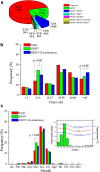Oropouche infection a neglected arbovirus in patients with acute febrile illness from the Peruvian coast
- PMID: 32041646
- PMCID: PMC7011230
- DOI: 10.1186/s13104-020-4937-1
Oropouche infection a neglected arbovirus in patients with acute febrile illness from the Peruvian coast
Abstract
Objective: To evaluate the frequency of infection caused by the Oropouche virus (OROV) in 496 patients with acute febrile disease (AFI), whose samples were obtained for the analysis of endemic arboviruses in a previous investigation carried out in 2016.
Results: OROV was detected in 26.4% (131/496) of serum samples from patients with AFI. Co-infections with Dengue virus (7.3%), Zika virus (1.8%) and Chikungunya (0.2%) were observed. The most common clinical symptoms reported among the patients with OROV infections were headache 85.5% (112/131), myalgia 80.9% (106/131), arthralgia 72.5% (95/131) and loss of appetite 67.9% (89/131). Headache and myalgia were predominant in all age groups. Both OROV infections and co-infections were more frequent in May, June and July corresponding to the dry season of the region.
Keywords: Arbovirus; Chikungunya; Dengue; Oropouche; PCR; Peru; Zika.
Conflict of interest statement
On behalf of all authors, the corresponding author states that there are no conflicts of interest or funding related to this study.
Figures
Similar articles
-
(Re-)Emergence of Oropouche Virus (OROV) Infections: Systematic Review and Meta-Analysis of Observational Studies.Viruses. 2024 Sep 22;16(9):1498. doi: 10.3390/v16091498. Viruses. 2024. PMID: 39339974 Free PMC article.
-
Oropouche Virus Exposure in Febrile Patients during Chikungunya Virus Introduction in the State of Amapá, Amazon Region, Brazil.Pathogens. 2024 Jun 3;13(6):469. doi: 10.3390/pathogens13060469. Pathogens. 2024. PMID: 38921767 Free PMC article.
-
Identification of infection by Chikungunya, Zika, and Dengue in an area of the Peruvian coast. Molecular diagnosis and clinical characteristics.BMC Res Notes. 2018 Mar 14;11(1):175. doi: 10.1186/s13104-018-3290-0. BMC Res Notes. 2018. PMID: 29540220 Free PMC article.
-
Arbovirus investigation in patients from Mato Grosso during Zika and Chikungunya virus introdution in Brazil, 2015-2016.Acta Trop. 2019 Feb;190:395-402. doi: 10.1016/j.actatropica.2018.12.019. Epub 2018 Dec 12. Acta Trop. 2019. PMID: 30552880
-
Oropouche Virus (OROV) in Pregnancy: An Emerging Cause of Placental and Fetal Infection Associated with Stillbirth and Microcephaly following Vertical Transmission.Viruses. 2024 Sep 9;16(9):1435. doi: 10.3390/v16091435. Viruses. 2024. PMID: 39339911 Free PMC article. Review.
Cited by
-
(Re-)Emergence of Oropouche Virus (OROV) Infections: Systematic Review and Meta-Analysis of Observational Studies.Viruses. 2024 Sep 22;16(9):1498. doi: 10.3390/v16091498. Viruses. 2024. PMID: 39339974 Free PMC article.
-
(Re)Emerging Arboviruses of Public Health Significance in the Brazilian Amazon.Microorganisms. 2025 Mar 12;13(3):650. doi: 10.3390/microorganisms13030650. Microorganisms. 2025. PMID: 40142542 Free PMC article. Review.
-
Re-emergence of Oropouche virus as a novel global threat.Curr Res Microb Sci. 2025 May 19;8:100406. doi: 10.1016/j.crmicr.2025.100406. eCollection 2025. Curr Res Microb Sci. 2025. PMID: 40510237 Free PMC article. Review.
-
Protein-based tools for the detection and characterisation of Oropouche virus infection.EMBO Mol Med. 2025 Aug 11. doi: 10.1038/s44321-025-00291-7. Online ahead of print. EMBO Mol Med. 2025. PMID: 40790101
-
Leptospirosis in febrile patients with suspected diagnosis of dengue fever.BMC Res Notes. 2021 May 29;14(1):209. doi: 10.1186/s13104-021-05627-3. BMC Res Notes. 2021. PMID: 34051849 Free PMC article.
References
MeSH terms
Supplementary concepts
Grants and funding
LinkOut - more resources
Full Text Sources
Medical


